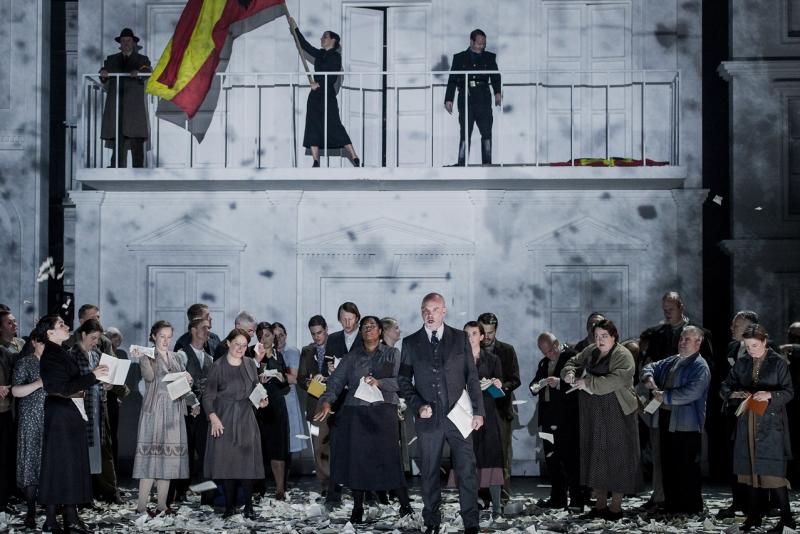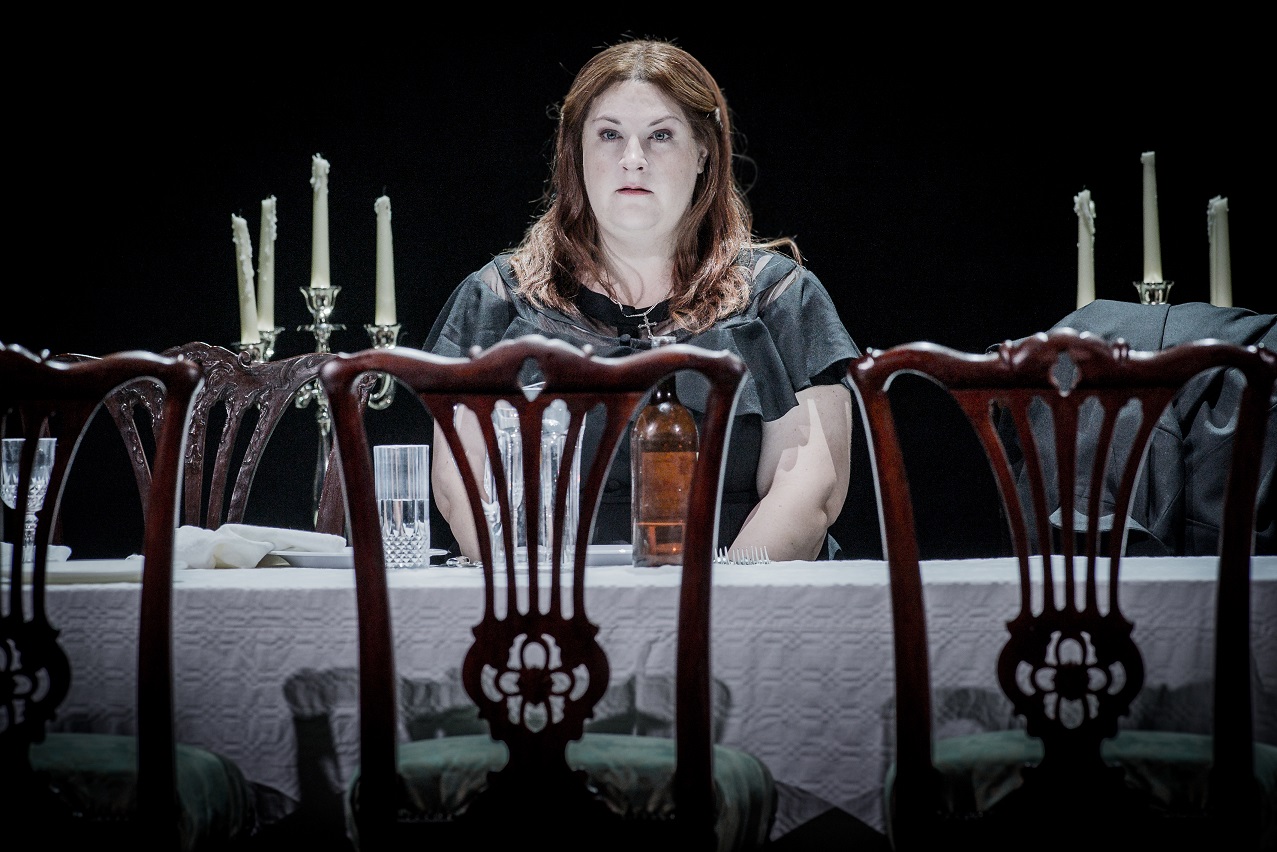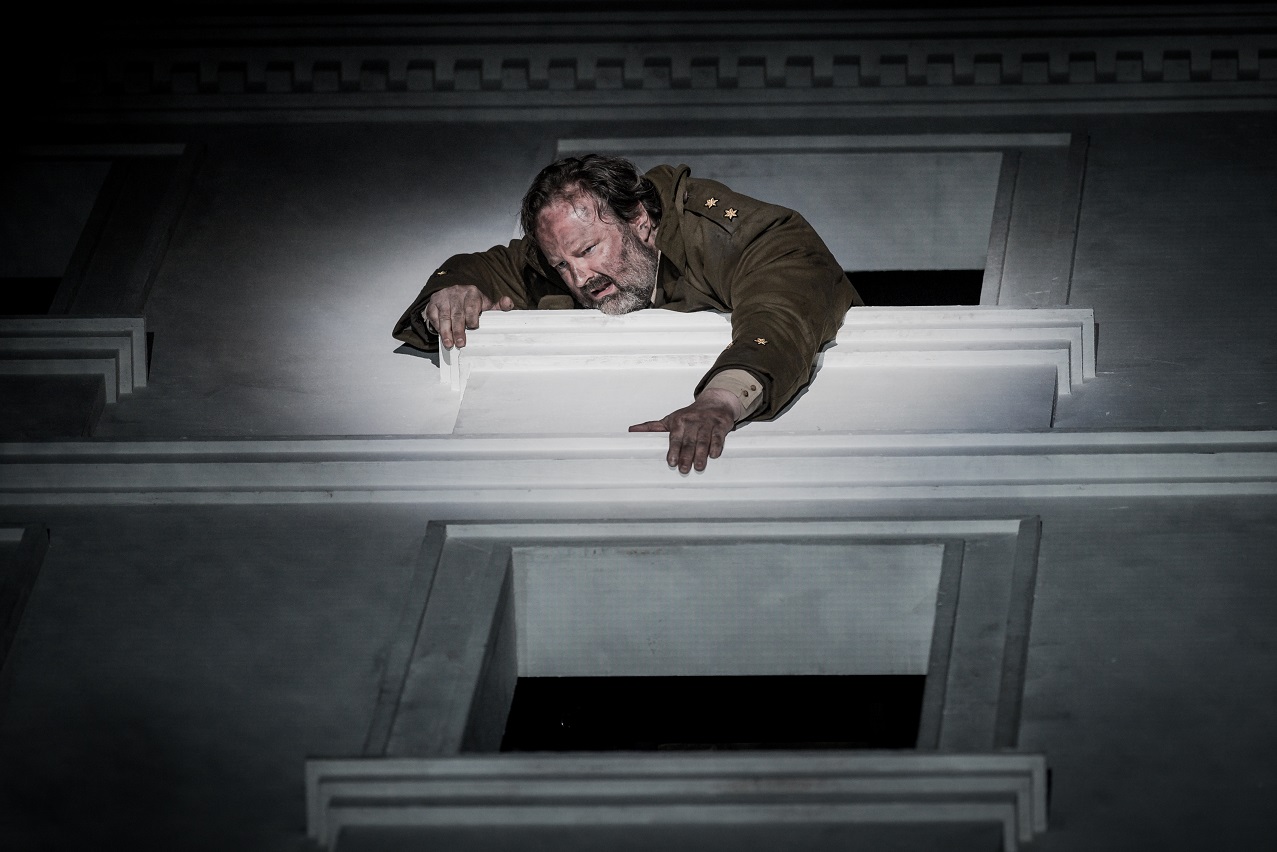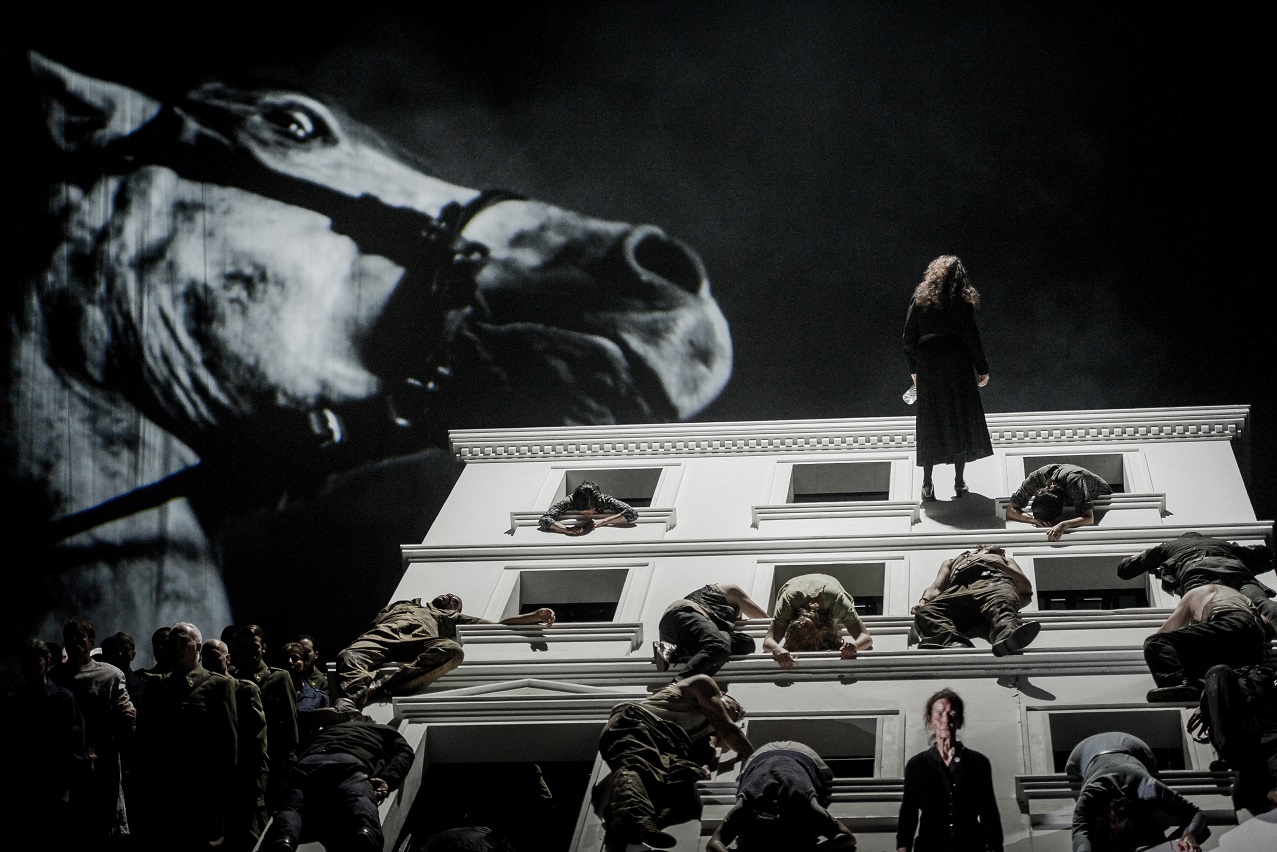The Force of Destiny, English National Opera | reviews, news & interviews
The Force of Destiny, English National Opera
The Force of Destiny, English National Opera
Bieito channels Picasso for a grim but compelling update of Verdi’s tragedy

Verdi’s dark tale gets even darker in this new staging from Calixto Bieito. He updates the story to the Spanish Civil War, a setting with plenty of opportunity for his trademark violence but also offering illuminating parallels on the story itself. ENO has assembled a fine cast for the occasion, and the musical direction, from Mark Wigglesworth, is dynamic and dramatically engaged.
Bieito explains that the civil war setting offers a parallel to the central family drama of the opera: the Vargas family torn apart through their incapability for reconciliation. As in civil war, the enemy is within. Visually, the setting takes on a greying monochrome, partly referencing newsreel footage, but also Picasso’s Guernica, and at one point the image of a startled horse is projected against the backdrop to make that connection explicit. One area that doesn’t lend itself to subtlety is the evocation of fascism, and the first two acts are weighed down with oppressive back projections of goose-stepping soldiers and giant jackboots. There is also a book-burning, or at least tearing-up, scene in the second act that seems heavy-handed. But the civil war angle works, especially for the specific context it provides for the ill-defined wartime setting of the libretto.
Three-storey terraced buildings dominate the stage throughout, two-dimensional facades, each supported behind by a small scaffold. The backs become as visible as the fronts, as each is moved around and, at one point, all are set in continuous rotation on the revolving stage. None of this adds much to the drama; the facades are set at oblique angles to convey the trauma of the fourth act, but are otherwise left to their own devices. They make for ambiguous scenarios, none of which do more than suggest the settings, but the abstraction allows the drama to take place on a more physiological level, its contexts more imagined than defined.

Strong performances in the lead roles energise this staging from the start. The first act is dominated by the Leonora of Tamara Wilson (pictured above). She has a commanding voice, emotive and well-projected. It’s not especially pretty, but it’s ideal for the part. Both she and Gwyn Hughes Jones as Alvaro (pictured below) seem a little inhibited in this first act, but that may be deliberate: the starting-point in a long emotional journey. Jones has a strong, robust tenor, another excellent Verdi voice. Anthony Michaels-Moore (pictured top) is equally compelling as Carlo. His big aria in the second act is compromised by noisy book-tearing, but he has the vocal power to be heard above it all, and plenty more chances to shine later on.
The ambiguous sets seem designed to deliberately compromise the sanctuary of the church, making this wartime environment even more hostile to Leonora. Her initiation into the hermitage is provocatively sadomasochistic, involving a barbed-wire crown of thorns (spoiler: she garrottes herself with it at the end – nasty). But there is humanity, and even humour, in the Father Superior of James Creswell and Melitone of Andrew Shore. Creswell hasn’t quite the profundo the role calls for, but plenty of authority nonetheless, and Shore makes the most of the relatively small part of Melitone, making a real character out of the conflicted and sarcastic friar.
 Act Three brings out Bieito’s more visceral instincts, with several instances of arbitrary violence. Preziosilla, the soldier’s widow inciting the troops, is a wholly unredeemed figure here, and Rinat Shaham’s icy performance and brittle tone are ideal. Some of the violence seems gratuitous and silly, like when she beats up a heavily pregnant woman while singing her first aria. But the “Rataplan” chorus works well as a gangland execution scene, Verdi’s music finally approaching the savagery that Bieito has been projecting on it.
Act Three brings out Bieito’s more visceral instincts, with several instances of arbitrary violence. Preziosilla, the soldier’s widow inciting the troops, is a wholly unredeemed figure here, and Rinat Shaham’s icy performance and brittle tone are ideal. Some of the violence seems gratuitous and silly, like when she beats up a heavily pregnant woman while singing her first aria. But the “Rataplan” chorus works well as a gangland execution scene, Verdi’s music finally approaching the savagery that Bieito has been projecting on it.
While some of the dramaturgy earlier on is hit-and-miss, this production comes into its own in the final act. Bieito has been described as the Quentin Tarantino of opera, and the epithet is fully vindicated here. He plays it like a Spaghetti Western, Carlo and Alvaro, the old adversaries, meeting in the ruins of a monastery for their final showdown. Anthony Michaels-Moore is compelling, a graphic portrayal of a psychosis induced by the quest for revenge. Bieito delivers a final elegant touch by setting the final scene, not in a hermit’s cave, but at the dining-table at which the first act played out, the chairs still in disarray from the shooting many years before.

Subtleties like that are not what Bieito is known for, but they are everywhere apparent in this production. He is working here with a fine and dramatically engaged cast. Mark Wigglesworth directs a musical performance that is a little more grounded and safe than the production itself, although the balance between the two is effective. The orchestra plays well for him, although sometimes feels constrained by the sheer control he applies (and when he does loosen the reins, as in the third act bacchanal, the co-ordination suffers). But overall, this feels like a strong company project, with everyone at ENO committed to the vision of their enfant terrible director, even though this production shows worrying signs he might actually be growing up.
- The Force of Destiny at ENO to December 4; it will be broadcast on BBC Radio 3 on Boxing Day
- Tamara Wison visits David Nice's Opera in Depth course at the Frontline Club on Monday 23 November, 2.30-4.30pm
- theartsdesk's David Nice discusses the production with Tom Service on BBC Radio 3's Music Matters
rating
Share this article
The future of Arts Journalism
You can stop theartsdesk.com closing!
We urgently need financing to survive. Our fundraising drive has thus far raised £49,000 but we need to reach £100,000 or we will be forced to close. Please contribute here: https://gofund.me/c3f6033d
And if you can forward this information to anyone who might assist, we’d be grateful.

Subscribe to theartsdesk.com
Thank you for continuing to read our work on theartsdesk.com. For unlimited access to every article in its entirety, including our archive of more than 15,000 pieces, we're asking for £5 per month or £40 per year. We feel it's a very good deal, and hope you do too.
To take a subscription now simply click here.
And if you're looking for that extra gift for a friend or family member, why not treat them to a theartsdesk.com gift subscription?
more Opera
 Tosca, Welsh National Opera review - a great company reduced to brilliance
The old warhorse made special by the basics
Tosca, Welsh National Opera review - a great company reduced to brilliance
The old warhorse made special by the basics
 BBC Proms: The Marriage of Figaro, Glyndebourne Festival review - merriment and menace
Strong Proms transfer for a robust and affecting show
BBC Proms: The Marriage of Figaro, Glyndebourne Festival review - merriment and menace
Strong Proms transfer for a robust and affecting show
 BBC Proms: Suor Angelica, LSO, Pappano review - earthly passion, heavenly grief
A Sister to remember blesses Puccini's convent tragedy
BBC Proms: Suor Angelica, LSO, Pappano review - earthly passion, heavenly grief
A Sister to remember blesses Puccini's convent tragedy
 Orpheus and Eurydice, Opera Queensland/SCO, Edinburgh International Festival 2025 review - dazzling, but distracting
Eye-popping acrobatics don’t always assist in Gluck’s quest for operatic truth
Orpheus and Eurydice, Opera Queensland/SCO, Edinburgh International Festival 2025 review - dazzling, but distracting
Eye-popping acrobatics don’t always assist in Gluck’s quest for operatic truth
 MARS, Irish National Opera review - silly space oddity with fun stretches
Cast, orchestra and production give Jennifer Walshe’s bold collage their all
MARS, Irish National Opera review - silly space oddity with fun stretches
Cast, orchestra and production give Jennifer Walshe’s bold collage their all
 Káťa Kabanová, Glyndebourne review - emotional concentration in a salle modulable
Janáček superbly done through or in spite of the symbolism
Káťa Kabanová, Glyndebourne review - emotional concentration in a salle modulable
Janáček superbly done through or in spite of the symbolism
 Buxton International Festival 2025 review - a lavish offering of smaller-scale work
Allison Cook stands out in a fascinating integrated double bill of Bernstein and Poulenc
Buxton International Festival 2025 review - a lavish offering of smaller-scale work
Allison Cook stands out in a fascinating integrated double bill of Bernstein and Poulenc
 Tosca, Clonter Opera review - beauty and integrity in miniature
Happy surprises and a convincing interpretation of Puccini for today
Tosca, Clonter Opera review - beauty and integrity in miniature
Happy surprises and a convincing interpretation of Puccini for today
 Hamlet, Buxton International Festival review - how to re-imagine re-imagined Shakespeare
Music comes first in very 19th century, very Romantic, very French operatic creation
Hamlet, Buxton International Festival review - how to re-imagine re-imagined Shakespeare
Music comes first in very 19th century, very Romantic, very French operatic creation
 Falstaff, Glyndebourne review - knockabout and nostalgia in postwar Windsor
A fat knight to remember, and snappy stagecraft, overcome some tedious waits
Falstaff, Glyndebourne review - knockabout and nostalgia in postwar Windsor
A fat knight to remember, and snappy stagecraft, overcome some tedious waits
 Salome, LSO, Pappano, Barbican review - a partnership in a million
Asmik Grigorian is vocal perfection in league with a great conductor and orchestra
Salome, LSO, Pappano, Barbican review - a partnership in a million
Asmik Grigorian is vocal perfection in league with a great conductor and orchestra
 Semele, Royal Opera review - unholy smoke
Style comes and goes in a justifiably dark treatment of Handelian myth
Semele, Royal Opera review - unholy smoke
Style comes and goes in a justifiably dark treatment of Handelian myth

Add comment